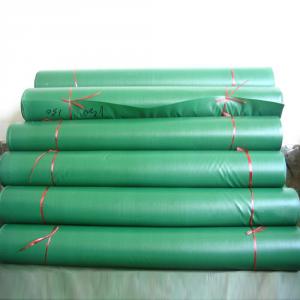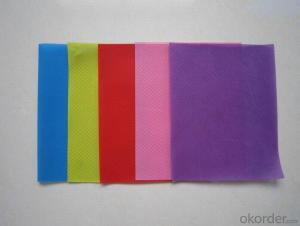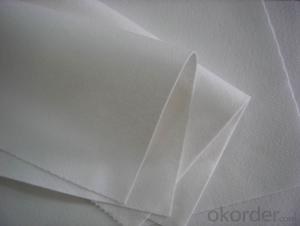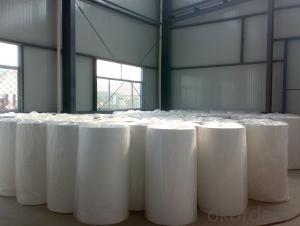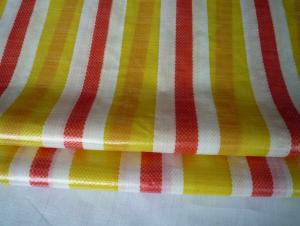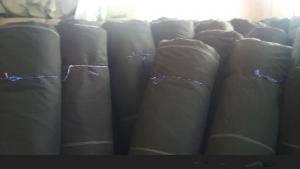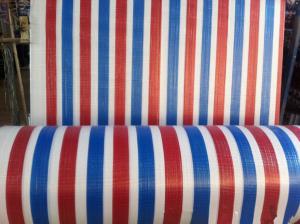Nonwoven Interlining Nonwoven Fabrics Manufacturer PET Non Woven Fabric 1020H/F 1025H/F
- Loading Port:
- Shanghai
- Payment Terms:
- TT OR LC
- Min Order Qty:
- 1000 roll
- Supply Capability:
- 10000 roll/month
OKorder Service Pledge
OKorder Financial Service
You Might Also Like
 PP non woven weed control mat is made of environmentally friendly raw materials, pp spunbond nonwoven fabric. It used to prevent the growth of weed, without the use of potentially dangerous chemical sprays or labor intensive hoeing. Once installed, weed mat will continue providing protection for years without maintenance.
PP non woven weed control mat is made of environmentally friendly raw materials, pp spunbond nonwoven fabric. It used to prevent the growth of weed, without the use of potentially dangerous chemical sprays or labor intensive hoeing. Once installed, weed mat will continue providing protection for years without maintenance.
They are permeable fabrics, which allow air, water and nutrients to pass through, and designed to block out the sun to reduce photosynthesis and stop weed growth.

The use of landscaping fabrics has become extremely popular in recent years for many reasons:
1. Leisure time is maximised - the need for weeding and on-going maintenance is minimised
2. Environmentally friendly - no need for chemical based weed killers
3. Promotes healthier plants - it allows the soil to breath and water to permeate
We offer different types of weed control fabrics to suit all applications and budgets.
1. Available in a range of sizes & materials to suit various applications from small to large landscaping projects, in both commercial and domestic situations.
2. All our landscape fabrics are UV stabilised
3. Ideal for use under paths, patios, decking, paving, bark mulch, gravel etc.
FEATURES:
1. Weed suppressant and drainage control landscaping fabric
2. Spun bonded non-woven fabric – will not fray when cut
3. Easy to use
4. Environmentally friendly
5. Allows water, air and nutrients through, suppressing weeds without the use of chemicals
6. Good alternative to Plantex® where cost is a factor
7. UV Stabilised
8. Reduces the level of watering required due to the slower rate of water evaporation
FUNCTION:
1. Cover crops in the ground surface,prevent weeds and against the insect
2. Controlling soil humidity and the temperature
3. Does not affect the growth of the crops
4. Protects plants from harmfully solar radiation
5. Air permeability, water permeability help crops growth.
6. Mothproof, eco-friendly, breathable, anti-bacteria, tear-resistant, fusible
APPLICATIONS:
1. Weed block for landscaped garden beds
2. Permeable liners for planters (stops soil erosion)
3. Weed control under wooden decking
4. Geotextile for separating aggregate / soils under walkway blocks or bricks
5. Assists in preventing paving from settling unevenly
6. Landscape fabric prevents soil erosion
Health - Hygiene & Medical
Surgical Gowns
Gloves
Face Masks
Foot covers
Diapers
Caps
Bedsheets
Curtains
Pillow Covers
Slippers
Packaging
Sleeping Bags
Tarpaulins
Tents
Artificial Leather
Bags for Rice/Sugar etc.
Luggage
Vacuum Cleaner Bags
Tea and Coffee Bags
Buff Pads
Shopping Bags

Agriculture
Crop Covers
Turf Protections
Nursery Over wintering
Weed Control Fabrics
Root Bags
Containers
Capillary Matting
Other types of covers
Furniture Upholstery
Roofing and Tile Underlayment
Acoustical Ceilings
Insulation
House wrap
Pipe wrap
Sofa and Mattress Lining
Shoes & Garments
Coveralls
Pillow cases
Airline Headrests
Interlinings
Clothing and Glove insulation
Bra and Shoulder Padding
ADVANTAGES:
1. Lower labour costs as no weeding maintenance for years;
2. Water seeps through and can conserve soil moisture for improved growing conditions;
3. Air escapes – humidity rises through the mat for a more controlled growing environment;
4. Increase crop yields close to 25% due to improved growing conditions and absence of water stress and competition of nutrients absorption from weeds;
5. Minimises bacteria and fungus problems especially Algae;
6. Strong, woven construction or pressed fibre sheet resists tears and punctures;
7. Resistant to mildew, rot, water, sunlight and most of the agricultural chemicals
8. Fertilizer is applied on the mat, thus helping the owner or estate manager to monitor the progress of manuring;
9. Prevents soil erosion or leaching of soil nutrients or fertilizers applied;
10. Environmental friendly.
FAQ:
Q .What is the material of the non woven fabric ?
A .PP spunbond non woven fabric
Grade A: 100% Polypropylene
Grade B: 90% Polypropylene +10% filling
Q .What about the width of the non woven fabric ?
A .We can cut the fabric as your requirement. Our width of machine is 240cm, so the max of the width is 240cm
Q .What about the color ?
A .Any color is available. You just need to give me the Panton Num or send me your sample. Then we will make the color samples to you for approve
Q .What about the GSM ?
A .The thinnest of the fabric that we can produce is 9g, and the thickest is 250g. Normally the fabric that used in bag making is 50-100g, the agricultural used is 17-50g, the home used fabric is 40g and so on...
Q .What about the delivery time ?
A .We can finish the production in 2-3 days (40ft HQ)
Q .What about the price ?
A .We are the factory of the PP nonwoven fabric, We can supply you with good quality and favorable price
- Q: What kind of fiber can be used as textile fiber
- Fibers derived from plant bursa such as flax, jute, apricot and the like; fibers derived from plant leaves such as sisal, abaca and the like. The main chemical composition of plant fiber is cellulose, it is also known as cellulose fiber
- Q: Antistatic fabrics of textile electrostatic materials
- Clothing charged, a large number of adsorption of dust, easy to contaminate, and clothing and the human body, clothing and clothing will occur entanglement phenomenon or produce spark. Therefore, the electrostatic interference, affecting the smooth progress of processing, affecting the quality of the product and the performance of the fabric, etc.
- Q: What is the difference between the nonwovens industry and the textile industry?
- To know the difference between the nonwovens and the textile industry, first look at the difference between nonwovens and textiles
- Q: Processing of textiles, processed products were detected formaldehyde exceeded, how to deal with
- First look at how much formaldehyde you exceeded. General formaldehyde in the national regulations have three limits: 1, infant supplies (36 months) shall not exceed 20PPM,
- Q: Performance requirements for textile fibers
- Fiber wear resistance. Fibers and their products in the processing and the actual use of the process, due to continue to withstand friction caused by wear and tear. Fiber wear resistance refers to the fiber resistance to external wear performance
- Q: What is the number of raw materials for textile enterprises?
- General varieties are used, PVA, modified starch and other main pulp, plus propylene and wax tablets and other additives,
- Q: China is now optimistic about which one of the textile industry
- Special decorative textiles industry multi-functional high-level tent materials, automotive lightweight cover and interior materials, membrane structure materials and other special decorative textiles processing technology and industrial applications.
- Q: What is the imo standard in the textile industry?
- International Association for the International Textile Industry (IVN), Soil Association (SA), Organic Trade Organization (OTA) and Japan Organic Cotton Association (JOCA) to develop global organic textile standards.
- Q: Classification of cotton textiles
- Clothing textiles, including the production of clothing and a variety of textile fabrics and sewing thread, elastic band, lined, lining and other textile accessories and knitted garments, gloves, socks and so on.
- Q: Today, the national textile market prospects
- January 29 this year, published statistics show that from January to November 2009, China's textile enterprises above designated size to achieve industrial output value of more than 342.68 billion yuan, an increase of 9.71%, growth rate from January to February (annual output growth Bottom), significantly picked up 7.08 percentage points.
Send your message to us
Nonwoven Interlining Nonwoven Fabrics Manufacturer PET Non Woven Fabric 1020H/F 1025H/F
- Loading Port:
- Shanghai
- Payment Terms:
- TT OR LC
- Min Order Qty:
- 1000 roll
- Supply Capability:
- 10000 roll/month
OKorder Service Pledge
OKorder Financial Service
Similar products
Hot products
Hot Searches
Related keywords







